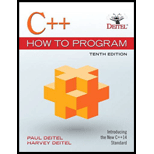
Concept explainers
(Removing Duplicated Code in the main Function) In Fig. 3.9, the main function contains six statements (lines 14-15, 16-17, 26-27, 28-29, 37-38 and 39-40) that each display an Account object's name and balance. Study these statements and you'll notice that they differ only in the Account object being manipulated-accountl or account2. In this exercise, you'll define a new displayAccount function that contains one copy of that output statement. The member function's parameter will be an Account Object and the member function will output the object's name and balance. You'll then replace the six duplicated statements in main with calls to displayAccount, passing as an argument the specific Account object to output.
-
Modify Fig. 3.9 to define the following displayAccount function after the using directive and before main:
void displayAccount(Account accountToDisplay) {
// place the statement that displays
// accountToDisplay's name and balance here
}
Replace the comment in the member function's body with a statement that displays accountToDisplay’s name and balance.
Once you've completed displayAccount’s declaration, modify main to replace the statements that display each Account’s name and balance with calls to displayAccount of the form:
displayAccount(nameOfAccountObject);
In each call, the argument should be the account1 or account2 object, as appropriate. Then, test the updated
Want to see the full answer?
Check out a sample textbook solution
Chapter 3 Solutions
C++ How to Program (Early Objects Version)
Additional Engineering Textbook Solutions
Introduction To Programming Using Visual Basic (11th Edition)
Database Concepts (8th Edition)
SURVEY OF OPERATING SYSTEMS
BASIC BIOMECHANICS
Fluid Mechanics: Fundamentals and Applications
Java: An Introduction to Problem Solving and Programming (8th Edition)
 C++ Programming: From Problem Analysis to Program...Computer ScienceISBN:9781337102087Author:D. S. MalikPublisher:Cengage Learning
C++ Programming: From Problem Analysis to Program...Computer ScienceISBN:9781337102087Author:D. S. MalikPublisher:Cengage Learning C++ for Engineers and ScientistsComputer ScienceISBN:9781133187844Author:Bronson, Gary J.Publisher:Course Technology Ptr
C++ for Engineers and ScientistsComputer ScienceISBN:9781133187844Author:Bronson, Gary J.Publisher:Course Technology Ptr Microsoft Visual C#Computer ScienceISBN:9781337102100Author:Joyce, Farrell.Publisher:Cengage Learning,
Microsoft Visual C#Computer ScienceISBN:9781337102100Author:Joyce, Farrell.Publisher:Cengage Learning,- COMPREHENSIVE MICROSOFT OFFICE 365 EXCEComputer ScienceISBN:9780357392676Author:FREUND, StevenPublisher:CENGAGE LProgramming Logic & Design ComprehensiveComputer ScienceISBN:9781337669405Author:FARRELLPublisher:Cengage




